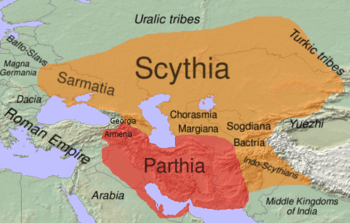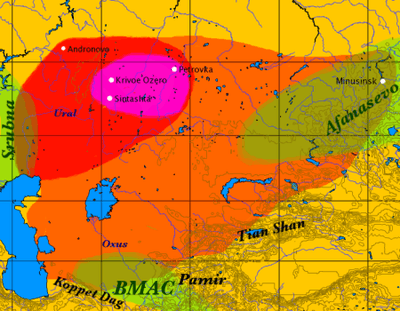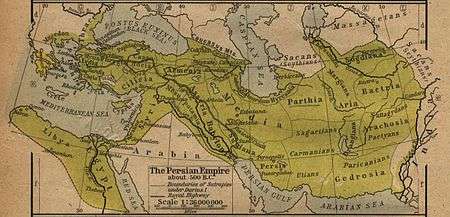List of ancient Iranian peoples
| Part of a series on |
| Indo-European topics |
|---|
 |
|
|
Origins |
|
Archaeology Pontic Steppe Caucasus East Asia Eastern Europe Northern Europe Pontic Steppe Northern/Eastern Steppe Europe
South Asia Steppe Europe Caucasus India |
|
Peoples and societies Indo-Aryans Iranians Europe East Asia Europe Indo-Aryan Iranian |
|
|

This list of ancient Iranian peoples or ancient Iranic peoples[1] includes names of Indo-European peoples speaking Iranian languages or otherwise considered Iranian in sources from the late 1st millennium BC to the early 2nd millennium AD.
Background


The Iranian languages form a sub-branch of the Indo-Iranian sub-family, which is a branch of the family of Indo-European languages. Having descended from the Proto-Indo-Iranians, the Proto-Iranians separated from the Proto-Indo-Aryans early in the 2nd millennium BCE.
Iranian peoples first appear in Assyrian records in the 9th century BCE. In Classical Antiquity, they were found primarily in Scythia (in Central Asia, Eastern Europe, the Balkans and the Northern Caucasus) and Persia (in Western Asia). They divided into "Western" and "Eastern" branches from an early period, roughly corresponding to the territories of Persia and Scythia, respectively. By the 1st millennium BCE, Medes, Persians, Bactrians and Parthians populated the Iranian plateau, while others such as the Scythians, Sarmatians, Cimmerians and Alans populated the steppes north of the Black Sea and the Caspian Sea, as far as the Great Hungarian Plain in the west. The Saka tribes remained mainly in the far-east, eventually spreading as far east as the Ordos Desert (North-Central China).
Ancient Iranian peoples lived in many regions, and they had as farthest geographical points dwelt by them: to the west the Great Hungarian Plain (Alföld), east of the Danube river, and to the east the Altay Mountains western and northwestern foothills and slopes, western Gansu and even Ordos in northwestern China, to the north southern West Siberia and southern Ural Mountains/Riphean Mountains and to the south the northern coasts of the Persian Gulf and the Arabian Sea. The geographical area dwelt by ancient Iranian peoples was therefore vast (at the end of the 1st Millennium BC they dwelt in an area of several million square kilometers or miles thus roughly corresponding to half or slightly more than half of the geographical area that all Indo-European peoples dwelt in Eurasia).
During Late Antiquity, the Iranian populations of Scythia and Sarmatia in the Eurasian Steppe were marginalized and assimilated by Germanic, Slavic and Turkic migrations. By the 10th century, the Eastern Iranian languages were no longer spoken in many of the territories they were once spoken, with the exception of Pashto in Central Asia, Ossetic in the Northern Caucasus and Pamiri languages in Badakhshan. Various Persian empires flourished throughout antiquity, and fell to the Islamic conquest in the 7th century.
List

- Ancient Iranian Peoples
- East Iranians
- Northeast Iranians
- Dahae
- Khwarezmians/Chorasmians
- Massagetae
- Saka/Sacans (Sakā) - Sarmatians and Scythians (Sakā was an Old Persian generic word for all Scythians and Sarmatians that lived in the Steppe)
- Sarmatians
- Eastern Saka/Sarmatians (Sakā para Sugudam - Beyond Sogdiana Sakas)
- Amyrgians (Sakā haumavargā - Soma Drinkers/Gatherers Sakas)
- Indo-Scythians
- Orthocorybantians (Sakā tigraxaudā - Pointed Caps/Hats Sakas)
- Western Saka/Sarmatians
- Aorsi (Yancai was the Chinese name of a State that could be identical of an Aorsi one)
- Alans (a descendant people of the Aorsi Sarmatians) (Ossetians/Irættæ are a modern branch)
- Iasi[2][3] (Iasi/Jassi/Jasz are descendants from a group of Alans that migrated towards West, they are related but not identical to the oldest Iazyges)
- Roxolani (an offshoot and eastern branch of the Alans)
- Banat Roxolani (a branch of the Roxolani that migrated towards West)
- Agaragantes/Arcaragantes (Free Sarmatians)
- Lemigantes
- Banat Roxolani (a branch of the Roxolani that migrated towards West)
- Alans (a descendant people of the Aorsi Sarmatians) (Ossetians/Irættæ are a modern branch)
- Iazyges/Iazyges Metanastae/Iaxamatae
- Khorouathoi/Choruathi/Haravati
- Serboi
- Siraces/Siraci
- Tyragetae[4] (may have been a Dacian-Getae people or tribe and not an Iranian one)
- Urgi[5]
- Aorsi (Yancai was the Chinese name of a State that could be identical of an Aorsi one)
- Eastern Saka/Sarmatians (Sakā para Sugudam - Beyond Sogdiana Sakas)
- Scythians/Scoloti/Sacans (Skolotoi/Saka) (Sakā para Draya - Beyond the Sea Sakas/Scythians - The Sea was the Pontus Euxinus/Black Sea)
- Agathyrsi
- Budini
- Gelonians/Geloni
- Tauri/Tauri Scythae/Tauroscythae, they lived in Taurica Peninsula (today's Crimea)
- Sarmatians
- Sogdians, possible ancestors of Yaghnobis (Kangju – Chinese name of a State probably identical to the Sogdians[6])
- Trybactae
- Thyssagetae
- Southeast Iranians
- Arachosians/Arachoti
- Ariaspae/Evergetae
- Arians/Arii
- Borgi
- Casirotae
- Bactrians
- Chomari
- Comi
- Drepsiani
- Oxiani
- Salatarae
- Tambyzi
- Zariaspae
- Gedrosians/Gedrosii/Gedroseni
- Arabitae/Arbies
- Paricanians/Paricanii/Oreitae/Orae (Old Persian Barikânu - Mountain people)
- Rhamnae
- Kambojas (an Avestan speaking group of East Iranians living in what is now Afghanistan, possible ancestors of Pamir peoples in the Pamir Mountains, roughly Badakhshan region of Tajikistan and Afghanistan and parts of the Hindu Kush/Paropamisus in east central Afghanistan and northwestern Pakistan)[7][8][9]
- Ashvakas: Scholars link the historical Afghans (modern Pakhtuns/Pashtuns) to the Ashvakas (the Ashvakayanas and Ashvayanas of Pāṇini or the Assakenoi and Aspasio of Arrian). The name Afghan is said to have derived from the Ashvakan of Sanskrit texts.[10][11][12] Ashvakas are identified as a branch of the Kambojas. This people was known, by Greek and Roman authors, as Assakanoi and Assacani. The similarity of the name Assacani with the name Sacae/Sacans/Sakas made that the two peoples were confused by Greeks and Romans (as is shown in the map regarding the Pamir mountains on the upper right edge of the map). However the Pamir mountains were dwelt by the Asvaka Kambojas and not by the Sacans although they were related peoples (they were both East Iranians, however the Asvaka Kambojas were Southeast Iranians and the Sacans/Sakas, Scythians or Sarmatians, were Northeast Iranians).
- Parama Kambojas, of the Alay Valley or Alay Mountains, north of Hindukush/Paropamisus in today's far southern Kyrgyzstan and far northwesternTajikistan. In ancient Sanskrit texts, their territory was known as Kumudadvipa and it formed the southern tip of the Sakadvipa or Scythia. In classical literature, this people are known as Komedes. Indian epic Mahabharata designates them as Parama Kambojas[13]
- Margians
- Drachamae
- Mycae
- Zarangians/Drangians/Drangae
- Northeast Iranians
- West Iranians
- Northwest Iranians
- Aenianes
- Amardians/Mardians
- Anariacae
- Astabeni
- Caspians[14]
- Cadusii[15]
- Carduchi/Corduchi[16]/Cyrtaei/Cyrtii (mentioned by Strabo and possible ancestors of the Kurds according to Muhammad Dandamayev) (See Carduchi in Encyclopædia Iranica)
- Derbiccans/Derbiccae/Derbices
- Dribyces
- Gelae/Gilites (possible ancestors of the Gilaks), although associate they were not the same people as the Cadusii
- Hyrcani, they lived in Hyrcania
- Medes
- Arizanti
- Budii
- Busae
- Magi
- Paraetaceni/Paraetacae/Paraetaci
- Sidices
- Struchates
- Vaddasi
- Parthians
- Tapurians
- Vitii
- Southwest Iranians
- Carmanians
- Arae
- Chudi
- Isatichae
- Proto Persians
- Parsua
- Persians
- Dai
- Derusiaei
- Dropici
- Germanii
- Maraphii
- Mardi
- Maspii
- Panthialaei
- Pasargadae (contained the clan of the Achaemenids from which Cyrus the Great, founder of the Persian Empire, was a member) Pasargadae, the first capital of the Persian Achaemenid Empire was in the land of this tribe and took its name from them
- Pateischoreis
- Rhapses
- Sagartians/Asagartians (whose name survives in the name of the Zagros Mountains)
- Soxotae
- Stabaei
- Suzaei
- Utians
- Carmanians
- Northwest Iranians
- East Iranians
Ancient peoples of uncertain origin with possible Iranian background
- Amazons, a semilegendary people or tribe of women warriors that greek authors such as Herodotus and Strabo said to be related to the Scythians and the Sarmatians, however there could be some historical background for a real people with iranian etymology (*ha-mazan- "warriors") that lived in Scythia and Sarmatia but they were later turned as base for a myth
- Antes, may have been a Slavic people and not an Iranian one
- Aparytae, may have been an Iranian people
- Arimaspi/Arimaspae, they lived north of the Scythians in the southeast foothills of the Riphean Mountains (Ural Mountains?) (although a semilegendary people or tribe there could be some historical background for a real people with iranian etymology (Ariama: love, and Aspa: horses) that lived in that region but they were later turned as base for a myth)
- Asii/Asioi/Osii, an ancient Indo-European people of Central Asia, during the 2nd and 1st Centuries BCE, known only from Classical Greek and Roman sources.
- Cimmerians[17], they could have been a people of Thracian-Dacian origin with an Iranian overlordship, a mixture of Thracians and Iranians or a missing link between Indo-Iranian peoples and Thracians and Dacians.
- Dadicae, may have been an Iranian people
- Hephthalites[18]
- Ichthyophagi/Ichthyophagoi (Fish-Eaters)
- Issedones, people that lived north and northeast of the Sarmatians and Scythians in Western Siberia or Chinese Turkestan (Xinjiang)
- Iyrcae/Iyrkai, people that lived northeast of the Thyssagetae
- Leucosyri (White Syrians)
- Maeotians, a group of peoples that dwelt in the Maeotian Lake (Azov Sea) and Palus Maeotis (Don river delta swamps) that may have been Cimmerians, Iranian people (Scythians), West Caucasian people (Circassians/Adyghe) with an Iranian overlordship or a mixture of Iranian and West Caucasian peoples
- Paropamisadae, they dwelt in the southern and eastern slopes of the Paropamisus Mountains (today's Hindu Kush in east central Afghanistan and northwestern Pakistan), (Para Upari Sena - "Beyond the Raised Land" in Old Persian), and in Gandhara region. They could have been an Iranian people or an old transitional people between Iranian and Indo-Aryan peoples and as such they may be the ancestors of the Nuristani people (until the end of the 19th century they were known as Kafirs because they were not Muslims, and practiced an ancient Indo-Iranian religion like today the Kalash people).
- Ambautae
- Cabolitae, in the region of Kabul (today's capital of Afghanistan)
- Par(g)yetae
- Parsii
- Rishikas, some historians believe the Rishikas were a part of, or synonymous with, the Kambojas. However, there are other theories regarding their origins.
- Sattagydans, people that dwelt in Sattagydia (Old Persian Thataguš, country of the "hundred cows"), may have been an Iranian people of Sindh with Indo-Aryan influence or the opposite, an Indo-Aryan people of Sindh with Iranian influence
- Sigynnae
- Tusharas, could be the name of a people that lived in Tukhara, another name for Bactria after the invasion of the Iranian Tocharians that came from the north and northeast (not to be confused with the people called Tocharians that were of another Indo-European branch of peoples, it seems to be a misnomer for them)
- Wusun[19] - some speculate that they were the same as the Issedones/Essedones
- Xiongnu (ruling class)[20]
- Xionites[21]
- Yuezhi[22][23]
See also
References
- ↑ Izady, Mehrdad R. "PERSIAN CARROT AND TURKISH STICK: Contrasting Policies Targeted at Gaining State Loyalty from Azeris and Kurds*." The International Journal of Kurdish Studies 3.2 (1989): 31.
- ↑ Mayer, Antun (April 1935). "Iasi". Journal of the Zagreb Archaeological Museum. 16 (1). Zagreb, Croatia: Archaeological Museum. ISSN 0350-7165.
- ↑ Schejbal, Berislav (2004). "Municipium Iasorum (Aquae Balissae)". Situla - dissertationes Musei nationalis Sloveniae. 2. Ljubljana, Slovenia: National Museum of Slovenia. pp. 99–129. ISSN 0583-4554.
- ↑ Prichard Cowles, James. "Ethnography of Europe. 3d ed. p433.1841". 17 January 2015. Houlston & Stoneman, 1841. Retrieved 17 January 2015.
- ↑ https://books.google.pt/books?id=ijJ4o2iorhkC&pg=PA122&lpg=PA121&ots=Pi4wk0Mtho&focus=viewport&dq=Royal+Sarmatians&hl=pt-PT#v=onepage&q=Royal%20Sarmatians&f=false
- ↑ Sinor, Denis (1 March 1990). The Cambridge History of Early Inner Asia, Volume 1. Cambridge University Press. p. 153. ISBN 0-521-24304-1. Retrieved 29 May 2015.
... the K'ang-chii who were perhaps the Sogdians of Iranian stock...
- ↑ Scholars like V. S. Aggarwala etc locate the Kamboja country in Pamirs and Badakshan (Ref: A Grammatical Dictionary of Sanskrit (Vedic): 700 Complete Reviews.., 1953, p 48, Vasudeva Sharana Agrawala, Surya Kanta, Jacob Wackernagel, Arthur Anthony Macdonell, Peggy Melcher – India; India as Known to Pāṇini: A Study of the Cultural Material in the Ashṭādhyāyī, 1963, p 38, Vasudeva Sharana Agrawala – India; The North-west India of the Second Century B.C., 1974, p 40, Mehta Vasishtha Dev Mohan – Greeks in India; The Greco-Shunga period of Indian history, or, the North-West India of the second century B.C, 1973, p 40, India) and the Parama Kamboja further north, in the Trans-Pamirian territories (See: The Deeds of Harsha: Being a Cultural Study of Bāṇa's Harshacharita, 1969, p 199, Vasudeva Sharana Agrawala).
- ↑ Dr Michael Witzel also extends Kamboja including Kapisa/Kabul valleys to Arachosia/Kandahar (See: Persica-9, p 92, fn 81. Michael Witzel).
- ↑ Cf: "Zoroastrian religion had probably originated in Kamboja-land (Bacteria-Badakshan)....and the Kambojas spoke Avestan language" (Ref: Bharatiya Itihaas Ki Rup Rekha, p 229-231, Jaychandra Vidyalankar; Bhartrya Itihaas ki Mimansa, p 229-301, J. C. Vidyalankar; Ancient Kamboja, People and the Country, 1981, p 217, 221, J. L. Kamboj)
- ↑ "The name Afghan has evidently been derived from Asvakan, the Assakenoi of Arrian..." (Megasthenes and Arrian, p 180. See also: Alexander's Invasion of India, p 38; J. W. McCrindle)
- ↑ "Even the name Afghan is Aryan being derived from Asvakayana, an important clan of the Asvakas or horsemen who must have derived this title from their handling of celebrated breeds of horses" (See: Imprints of Indian Thought and Culture abroad, p 124, Vivekananda Kendra Prakashan)
- ↑ "Afghans are Assakani of the Greeks; this word being the Sanskrit Ashvaka meaning 'horsemen" (Ref: Sva, 1915, p 113, Christopher Molesworth Birdwood)
- ↑ Mahabharata 2.27.25.
- ↑ Rüdiger Schmitt in Encyclopædia Iranica, s.v. "Caspians"
- ↑ Rüdiger Schmitt, "Cadusii" in Encyclopædia Iranica
- ↑
- ↑ "Cimmerian". Encyclopædia Britannica Online. Encyclopædia Britannica, Inc. Retrieved 29 May 2015.
The origin of the Cimmerians is obscure. Linguistically they are usually regarded as Thracian or as Iranian, or at least to have had an Iranian ruling class.
- ↑ Sinor, Denis (1 March 1990). The Cambridge History of Early Inner Asia, Volume 1. Cambridge University Press. p. 300. ISBN 0-521-24304-1. Retrieved 29 May 2015.
There is no consensus concerning the Hephthalite language, though most scholars seem to think that it was Iranian.
- ↑ Sinor, Denis (1997). Aspects of Altaic Civilization III. Psychology Press. p. 237. ISBN 0-7007-0380-2. Retrieved 29 May 2015.
...it seems likely, the Wu-sun were an Indo-European, perhaps Iranian people...
- ↑ Harmatta, János (January 1, 1994). History of Civilizations of Central Asia: History of Civilizations of Central Asia: The Development of Sedentary and Nomadic Civilizations, 700 B. C. to A.D 250: Conclusion. UNESCO. p. 488. ISBN 9231028464. Retrieved 29 May 2015.
Their royal tribes and kings (shan-yii) bore Iranian names and all the Hsiung-nu words noted by the Chinese can be explained from an Iranian language of Saka type. It is therefore clear that the majority of Hsiung-nu tribes spoke an Eastern Iranian language.
- ↑ Felix, Wolfgang. "CHIONITES". Encyclopædia Iranica. Bibliotheca Persica Press. Retrieved 29 May 2015.
CHIONITES... a tribe of probable Iranian origin that was prominent in Bactria and Transoxania in late antiquity.
- ↑ "History of Central Asia: Early Eastern Peoples". Encyclopædia Britannica Online. Encyclopædia Britannica, Inc. Retrieved 1 June 2015.
... in the second half of the 2nd century bce the Xiongnu, at the height of their power, had expelled from their homeland in western Gansu (China) a people probably of Iranian stock, known to the Chinese as the Yuezhi and called Tokharians in Greek sources.
- ↑ "Ancient Iran: The movement of Iranian peoples". Encyclopædia Britannica Online. Encyclopædia Britannica, Inc. Retrieved 29 May 2015.
At the end of the 3rd century, there began in Chinese Turkistan a long migration of the Yuezhi, an Iranian people who invaded Bactria about 130 bc, putting an end to the Greco-Bactrian kingdom there. (In the 1st century bc they created the Kushān dynasty, whose rule extended from Afghanistan to the Ganges River and from Russian Turkistan to the estuary of the Indus.)
Literature
- H. Bailey, "ARYA: Philology of ethnic epithet of Iranian people", in Encyclopædia Iranica, v, pp. 681–683, Online-Edition, Link
- A. Shapur Shahbazi, "Iraj: the eponymous hero of the Iranians in their traditional history" in Encyclopædia Iranica, Online-Edition, Link
- R. Curzon, "The Iranian Peoples of the Caucasus", ISBN 0-7007-0649-6
- Jahanshah Derakhshani, "Die Arier in den nahöstlichen Quellen des 3. und 2. Jahrtausends v. Chr.", 2nd edition, 1999, ISBN 964-90368-6-5
- Richard Frye, "Persia", Zurich, 1963
External links
- - Strabo's work The Geography (Geographica). Book 11, Chapters 6 to 13, and Book 15, Chapters 2 and 3, are about regions dwelt by ancient Iranian peoples and tribes (each region has a chapter).